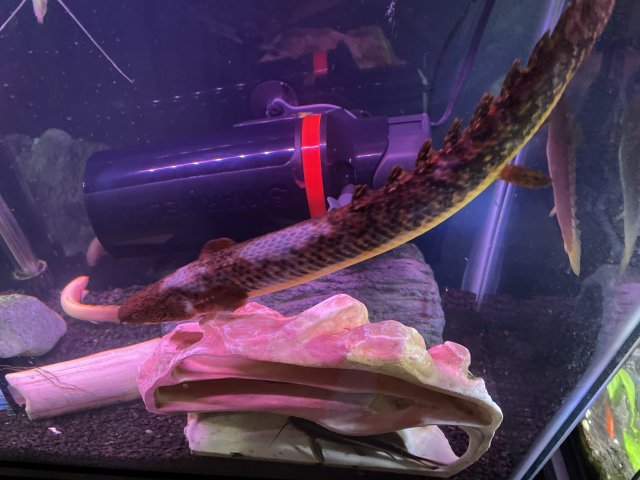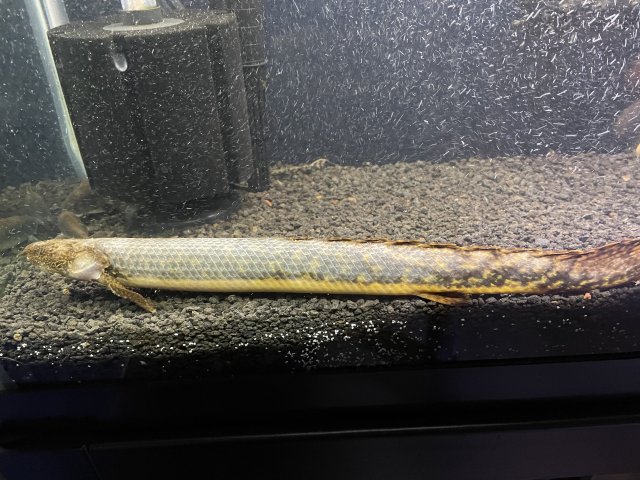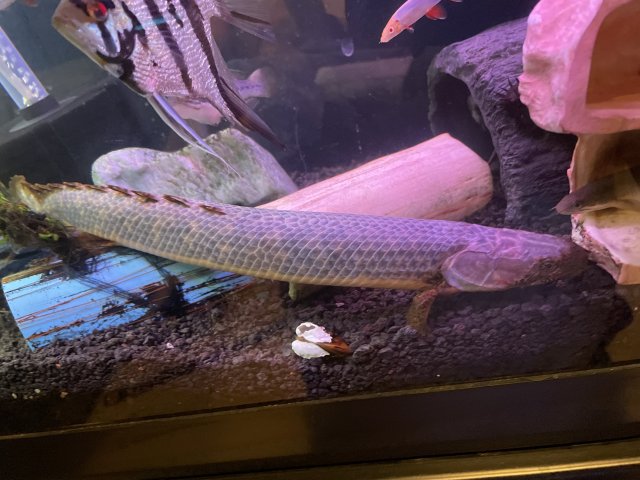- Have you tested your water?
- No
- If I did not test my water...
- ...I recognize that I will likely be asked to do a test, and that water tests are critical for solving freshwater health problems.
- Do you do water changes?
- Yes
- What percentage of water do you change?
- 21-30%
- How frequently do you change your water?
- Every month
- If I do not change my water...
- ...I recognize that I will likely be recommended to do a water change, and water changes are critical for preventing future freshwater health problems.
Hello! This is my first post on the forum, so sorry if I don't follow any guidelines - let me know and I'll fix the post right away.
I'm making this post on behalf of my friend, who's been having some health issues with the Teugelsi bichir in his 75-gallon tank. Recently (over the past month or so) she's begun developing large white patches of scales on her body, which have increased in size over time to cover nearly her entire body. We think the initial cause was a case of bichir worms, as several small translucent worms about half a centimeter long were seen hanging off her scales in the areas; he tried treating for anchorworms initially, but after three weeks of no change he switched to API General Cure and that seems to have eliminated them. The strange thing is that apart from the obvious discoloration issues, she hasn't been acting any different from normal: she's exhibiting normal behavior and is eating just fine (and has grown another 2 inches since this all began, in fact). Also, she shares the tank with two other bichirs (both senegals and much smaller than herself) and neither of them have shown signs of infection. Are the white scales actually a side effect of the worms, or are they an indicator of something else going on? If the former, should he be doing anything else to treat them or will they clear up on their own?
I read the diagnostic forum post and collected all of the information on the checklist from my friend, but I'm not sure what's relevant since I'm not a hobbyist myself and didn't want to just submit a huge bulleted list with no context. Let me know what you want to know more about and I'll reply with what I have. He has some figures about ammonia/nitrites/etc. but he didn't use a test to get them (I think he has little indicator stickers that show the general range?); he works at a Petco, though, so he can get a proper test very easily if need be. Ammonia and nitrites are both 0 and nitrates are 'low', pH is 'on the lower end but not acidic', temperature is 79-80 degrees Fahrenheit, and GH is 'high'. The tank is mostly gravel substrate with a small sandy area for burrowing fish and plenty of hiding places for the bichirs and other shy fish; he does a 25% water change once a month and vacuums the gravel at that time as well. The pictures attached are to give an idea of the progression of the patches: the first one is from the 27th and while still on anchorworm medication, while the second is from today and after 2 doses of API. (I'm also a little concerned because if you zoom in on the second picture it looks like there might be the start of a red spot about a quarter of the way down her body - not sure if that's anything?)


I'm making this post on behalf of my friend, who's been having some health issues with the Teugelsi bichir in his 75-gallon tank. Recently (over the past month or so) she's begun developing large white patches of scales on her body, which have increased in size over time to cover nearly her entire body. We think the initial cause was a case of bichir worms, as several small translucent worms about half a centimeter long were seen hanging off her scales in the areas; he tried treating for anchorworms initially, but after three weeks of no change he switched to API General Cure and that seems to have eliminated them. The strange thing is that apart from the obvious discoloration issues, she hasn't been acting any different from normal: she's exhibiting normal behavior and is eating just fine (and has grown another 2 inches since this all began, in fact). Also, she shares the tank with two other bichirs (both senegals and much smaller than herself) and neither of them have shown signs of infection. Are the white scales actually a side effect of the worms, or are they an indicator of something else going on? If the former, should he be doing anything else to treat them or will they clear up on their own?
I read the diagnostic forum post and collected all of the information on the checklist from my friend, but I'm not sure what's relevant since I'm not a hobbyist myself and didn't want to just submit a huge bulleted list with no context. Let me know what you want to know more about and I'll reply with what I have. He has some figures about ammonia/nitrites/etc. but he didn't use a test to get them (I think he has little indicator stickers that show the general range?); he works at a Petco, though, so he can get a proper test very easily if need be. Ammonia and nitrites are both 0 and nitrates are 'low', pH is 'on the lower end but not acidic', temperature is 79-80 degrees Fahrenheit, and GH is 'high'. The tank is mostly gravel substrate with a small sandy area for burrowing fish and plenty of hiding places for the bichirs and other shy fish; he does a 25% water change once a month and vacuums the gravel at that time as well. The pictures attached are to give an idea of the progression of the patches: the first one is from the 27th and while still on anchorworm medication, while the second is from today and after 2 doses of API. (I'm also a little concerned because if you zoom in on the second picture it looks like there might be the start of a red spot about a quarter of the way down her body - not sure if that's anything?)





